Adelomyrmex robustus
| Adelomyrmex robustus | |
|---|---|

| |
| Scientific classification | |
| Kingdom: | Animalia |
| Phylum: | Arthropoda |
| Class: | Insecta |
| Order: | Hymenoptera |
| Family: | Formicidae |
| Subfamily: | Myrmicinae |
| Tribe: | Solenopsidini |
| Genus: | Adelomyrmex |
| Species: | A. robustus |
| Binomial name | |
| Adelomyrmex robustus Fernández, 2003 | |
Adelomyrmex robustus occurs in mature cloud forest habitats, most often from 1600–1900 m elevation. It can be very abundant, occurring in over 90% of quantitative miniWinkler samples and being frequent at baits on the forest floor. It even appears to forage on low vegetation, occasionally occurring in beating samples. In many sites it is sympatric with Adelomyrmex paratristani, which can also be abundant, and two can be difficult to distinguish in samples. Project LLAMA participant D. J. Cox observed multiple nests in dead wood at a site in Chiapas. Nests of both A. robustus and Adelomyrmex paratristani'' were found in a single dead gall that contained several chambers. In other cases nests were found in close proximity to Perissomyrmex snyderi nests, in the same piece of rotten wood. Nests occurred with brood dispersed in multiple chambers.
Identification
This species can be differentiated from most Adelomyrmex by its size (HW equal or greater than 0.83 mm), tooth of the basal margin robust, as big or bigger than the third tooth of the masticatory margin, sculpturing formed by irregular rugulae mixed with conspicuous piliferous punctures. The propodeal spines are low and triangular. There is uniformity in size and other characteristics in the samples examined, all from Chiapas, Mexico. The workers of this species might be confused with large workers of Adelomyrmex tristani, although there are differences, as pointed out in the previous discussion of this species.
The queens can be differentiated, in addition to the characters already mentioned for the worker, by a single small, inconspicuous ocelli. The striation of the promesonotum is almost complete, with the smooth and shiny area small. The petiole seems to have a ventral anterior swelling.
Keys including this Species
Distribution
Southern Mexico, Guatemala.
Latitudinal Distribution Pattern
Latitudinal Range: 19.523333° to 14.55061798°.
| North Temperate |
North Subtropical |
Tropical | South Subtropical |
South Temperate |
- Source: AntMaps
Distribution based on Regional Taxon Lists
Neotropical Region: Guatemala, Mexico (type locality).
Distribution based on AntMaps
Distribution based on AntWeb specimens
Check data from AntWeb
Countries Occupied
| Number of countries occupied by this species based on AntWiki Regional Taxon Lists. In general, fewer countries occupied indicates a narrower range, while more countries indicates a more widespread species. |

|
Estimated Abundance
| Relative abundance based on number of AntMaps records per species (this species within the purple bar). Fewer records (to the left) indicates a less abundant/encountered species while more records (to the right) indicates more abundant/encountered species. |

|
Biology
Castes
Males have yet to be collected.
Worker
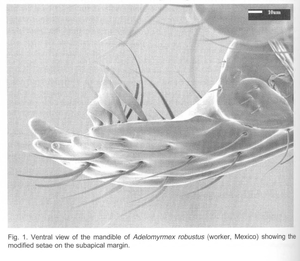 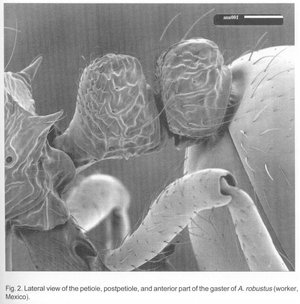  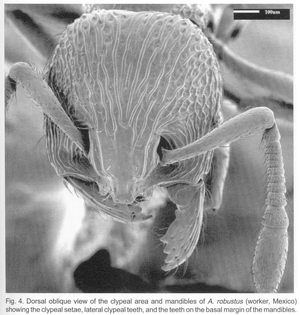
| |
| Worker. Photographer Fernandez, 2004. | |
Queen
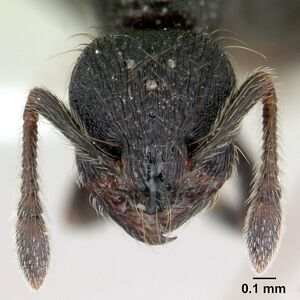   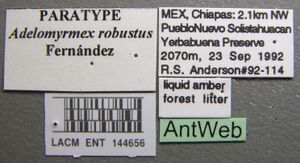
| |
| Queen. . | |
Nomenclature
The following information is derived from Barry Bolton's Online Catalogue of the Ants of the World.
- robustus. Adelomyrmex robustus Fernández, 2003b: 26, figs. 4-6, 25-30, 72 (w.q.) MEXICO (Chiapas).
- Type-material: holotype worker, 62 paratype workers, 10 paratype queens.
- Type-locality: Mexico: Chiapas, 8 mi. N Pueblo Nuevo, Solistahuacán, 6000 ft, 26-27.viii.1973, no. 12a, leaf litter, forest floor (A. Newton); paratypes: 36 workers, 9 queens Chiapas, 2.1 km. NW Pueblo Nuevo, Solistahuacán, Yerbabuena Preserve, 2100 m., 23.ix.1992, no. 92-114, liquid amber forest litter (R.S. Anderson), 20 workers Chiapas, 8 mi. N Pueblo Nuevo, Solistahuacán, 2.viii.1973 (no collector’s name; probably A. Newton), 3 workers, 1 queen Chiapas, Tapalapa, 12 km. N Capilla, 13.iii.1994, HR4 (R. Jones), 3 workers Chiapas, 5 km. E Rayón, 1700 m., 23.xii.1991, no. 11581-8 (P.S. Ward).
- Type-depositories: MZSP (holotype); BMNH, CPDC, IAVH, ICNB, IEXA, IMLT, INBC, JTLC, LACM, MCZC, MIZA, MZSP, USNM, WEMC (paratypes).
- Status as species: Branstetter & Sáenz, 2012: 257; Longino, 2012: 31.
- Distribution: Guatemala, Mexico.
Unless otherwise noted the text for the remainder of this section is reported from the publication that includes the original description.
Description
Worker
Holotype (Paratypes, n=10). HL 0.98 (0.93–0.96) HW 0.88 (0.83-0.88) SL 0.61 (0.59-0.64) EL 0.09 (0.10-0.13) WL 0.93 (0.91-0.95) GL 1.08 (1.09-1.13) TL 3.76 (3.59-3.70) CI 90 (89-90) SI 70 (71-73).
Head wider posteriorly. Mandibles with 5 stout teeth, the 3 apical bigger. Clypeal teeth and tooth of basal margin stout, size about medial masticatory teeth. Eyes moderate, with about 20 ommatidia. Hypostomal tooth very small. Promesonotum evenly convex. Propodeum armed with two spines small, pointed. Node of petiole thick, rounded above. Mandibles dorsally with strong longitudinal rugulations. Head frons longitudinally with rugulate, several rugulae irregular, meshed with notable piliferous punctures. Promesonotal dorsum with longitudinal coarse rugulae in the center, the rugulae more irregular in the periphery and with notable foveae. Petiole and postpetiole transversely rugulated. Legs and gaster smooth and shining. Hairs on the promesonotum very long, about 0.25 mm. Body black, appendages dark brown, tarsi yellowish.
Queen
Measurements: HL 0.98 HW 0.91 SL 0.63 EL 0.16 WL 1.03 GL 1.29 TL 4.09 CI 93 SI 69.
As worker, with the modifications typical of myrmicine queens.
Type Material
Holotype worker: MEXICO: Chiapas, 8 mi N Pueblo Nuevo, Solistahuacán, 6000 feet, 26–27.viii.1973, leaf litter forestry floor, A. Newton leg. No. 12a (Deposited in Museu de Zoologia da Universidade de Sao Paulo).
Paratype workers: MEXICO: 36 w, 9 q, Chiapas, 2.1 km NW Pueblo Nuevo, Solistahuacán, Yerbabuena Preserve, 2100 m, in liquid amber forest litter, 23.ix.1992, R.S. Andersen No. 92-114; 20 w, Chiapas, 8 mi Pueblo Nuevo, Solistahuacán, 26.viii.1973; 3 w, 1 q, Chiapas, Tapalapa, 12 km N Capilla, 13.iii.1994, R. Jones HR 4; 3 w, Chiapas, 5 km E Rayón, 1700 m, 23.xii.1991, P.S. Ward No. 11581-8 (PSW). Twenty six paratypes deposited in Los Angeles County Museum of Natural History, 17 paratypes deposited in Museu de Zoologia da Universidade de Sao Paulo, 22 paratypes deposited in CEPLAC, Instituto Nacional de Biodiversidad, Humboldt Institute, Insect Collection, Instituto de Ciencias Naturales, John T. Longino Collection, IEXM, Fundacion e Instituto Miguel Lillo , Museum of Comparative Zoology, Instituto de Zoologia Agricola, The Natural History Museum, National Museum of Natural History, William and Emma Mackay Collection.
References
- Fernández, F. 2003b. Revision of the myrmicine ants of the Adelomyrmex genus-group (Hymenoptera: Formicidae). Zootaxa 361: 1-52 (page 26, figs. 4-6, 25-30, 72 worker, queen described)
- Longino, J.T. 2012. A review of the ant genus Adelomyrmex Emery 1897 (Hymenoptera, Formicidae) in Central America. Zootaxa 3456, 1–35.
References based on Global Ant Biodiversity Informatics
- Dattilo W. et al. 2019. MEXICO ANTS: incidence and abundance along the Nearctic-Neotropical interface. Ecology https://doi.org/10.1002/ecy.2944
- Gonzalo Andrade-C. M., and J. D. Lynch. 2007. Los tipos nomenclatures depositaods en la colleccion zoologica del instituto de ciencias naturales. INSTITUTO DE CIENCIAS NATURALES-FACULTAD DE CIENCIAS UNIVERSIDAD NACIONAL DE COLOMBIA BIBLIOTECA JOSÉ JERÓNIMO TRIANA No. 16, 212 pages.
- Longino J. T. L., and M. G. Branstetter. 2018. The truncated bell: an enigmatic but pervasive elevational diversity pattern in Middle American ants. Ecography 41: 1-12.
- Longino, J.T. 2010. Personal Communication. Longino Collection Database
- Vásquez-Bolaños M. 2011. Lista de especies de hormigas (Hymenoptera: Formicidae) para México. Dugesiana 18: 95-133

